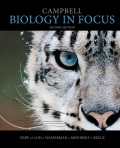
EBK CAMPBELL BIOLOGY IN FOCUS
2nd Edition
ISBN: 8220101459299
Author: Reece
Publisher: PEARSON
expand_more
expand_more
format_list_bulleted
Concept explainers
Question
Chapter 4.2, Problem 2CC
Summary Introduction
To calculate:
The ratio of an elongated cell that measures 125×1×1 arbitrary units. Predict how its surface to volume ratio would compare with reference to the Figure 4.6 “Geometric relationships”, in the textbook.
Introduction:
Surface to volume ratio is also called as surface area to volume ratio and it is denoted by SA:V. The ratio is the “amount of surface area per unit volume of object”.
Expert Solution & Answer
Want to see the full answer?
Check out a sample textbook solution
Students have asked these similar questions
glg 112 mid unit assignment Identifying melting processes
Give only the mode of inheritance consistent with all three pedigrees and only two reasons that support this, nothing more, (it shouldn't take too long)
O
Chapter 4 Solutions
EBK CAMPBELL BIOLOGY IN FOCUS
Ch. 4.1 - Prob. 1CCCh. 4.1 - Prob. 2CCCh. 4.2 - Briefly describe the structure and function of the...Ch. 4.2 - Prob. 2CCCh. 4.3 - What role do ribosomes play in carrying out...Ch. 4.3 - Describe the molecular composition of nucleoli,...Ch. 4.3 - WHAT IF? As a cell begins the process of dividing,...Ch. 4.4 - Describe the structural and functional...Ch. 4.4 - Describe how transport vesicles integrate the...Ch. 4.4 - WHAT IF? Imagine a protein that functions in the...
Ch. 4.5 - Describe two characteristics shared by...Ch. 4.5 - Prob. 2CCCh. 4.5 - Prob. 3CCCh. 4.6 - Prob. 1CCCh. 4.6 - WHAT IF? Males afflicted with Kartageners syndrome...Ch. 4.7 - In what way are the cells of plants and animals...Ch. 4.7 - Prob. 2CCCh. 4.7 - MAKE CONNECTIONS The polypeptide chain that makes...Ch. 4 - Which structure is not part of the endomembrane...Ch. 4 - Which structure is common to plant and animal...Ch. 4 - Which of the following is present in a prokaryotic...Ch. 4 - Prob. 4TYUCh. 4 - Cyanide binds to at least one molecule involved in...Ch. 4 - What is the most likely pathway taken by a newly...Ch. 4 - Which cell would be best for studying lysosomes?...Ch. 4 - DRAW IT From memory, draw two eukaryotic cells....Ch. 4 - SCIENTIFIC INQUIRY In studying micrographs of an...Ch. 4 - FOCUS ON EVOLUTION Compare different aspects of...Ch. 4 - FOCUS ON ORGANIZATION Considering some of the...Ch. 4 - Prob. 12TYU
Knowledge Booster
Learn more about
Need a deep-dive on the concept behind this application? Look no further. Learn more about this topic, biology and related others by exploring similar questions and additional content below.Similar questions
- Describe the principle of homeostasis.arrow_forwardExplain how the hormones of the glands listed below travel around the body to target organs and tissues : Pituitary gland Hypothalamus Thyroid Parathyroid Adrenal Pineal Pancreas(islets of langerhans) Gonads (testes and ovaries) Placentaarrow_forwardWhat are the functions of the hormones produced in the glands listed below: Pituitary gland Hypothalamus Thyroid Parathyroid Adrenal Pineal Pancreas(islets of langerhans) Gonads (testes and ovaries) Placentaarrow_forward
- Describe the hormones produced in the glands listed below: Pituitary gland Hypothalamus Thyroid Parathyroid Adrenal Pineal Pancreas(islets of langerhans) Gonads (testes and ovaries) Placentaarrow_forwardPlease help me calculate drug dosage from the following information: Patient weight: 35 pounds, so 15.9 kilograms (got this by dividing 35 pounds by 2.2 kilograms) Drug dose: 0.05mg/kg Drug concentration: 2mg/mLarrow_forwardA 25-year-old woman presents to the emergency department with a 2-day history of fever, chills, severe headache, and confusion. She recently returned from a trip to sub-Saharan Africa, where she did not take malaria prophylaxis. On examination, she is febrile (39.8°C/103.6°F) and hypotensive. Laboratory studies reveal hemoglobin of 8.0 g/dL, platelet count of 50,000/μL, and evidence of hemoglobinuria. A peripheral blood smear shows ring forms and banana-shaped gametocytes. Which of the following Plasmodium species is most likely responsible for her severe symptoms? A. Plasmodium vivax B. Plasmodium ovale C. Plasmodium malariae D. Plasmodium falciparumarrow_forward
- please fill in missing parts , thank youarrow_forwardplease draw in the answers, thank youarrow_forwarda. On this first grid, assume that the DNA and RNA templates are read left to right. DNA DNA mRNA codon tRNA anticodon polypeptide _strand strand C с A T G A U G C A TRP b. Now do this AGAIN assuming that the DNA and RNA templates are read right to left. DNA DNA strand strand C mRNA codon tRNA anticodon polypeptide 0 A T G A U G с A TRParrow_forward
arrow_back_ios
SEE MORE QUESTIONS
arrow_forward_ios
Recommended textbooks for you
 Human Physiology: From Cells to Systems (MindTap ...BiologyISBN:9781285866932Author:Lauralee SherwoodPublisher:Cengage Learning
Human Physiology: From Cells to Systems (MindTap ...BiologyISBN:9781285866932Author:Lauralee SherwoodPublisher:Cengage Learning Biology (MindTap Course List)BiologyISBN:9781337392938Author:Eldra Solomon, Charles Martin, Diana W. Martin, Linda R. BergPublisher:Cengage Learning
Biology (MindTap Course List)BiologyISBN:9781337392938Author:Eldra Solomon, Charles Martin, Diana W. Martin, Linda R. BergPublisher:Cengage Learning Biology 2eBiologyISBN:9781947172517Author:Matthew Douglas, Jung Choi, Mary Ann ClarkPublisher:OpenStax
Biology 2eBiologyISBN:9781947172517Author:Matthew Douglas, Jung Choi, Mary Ann ClarkPublisher:OpenStax Biology: The Dynamic Science (MindTap Course List)BiologyISBN:9781305389892Author:Peter J. Russell, Paul E. Hertz, Beverly McMillanPublisher:Cengage Learning
Biology: The Dynamic Science (MindTap Course List)BiologyISBN:9781305389892Author:Peter J. Russell, Paul E. Hertz, Beverly McMillanPublisher:Cengage Learning

Human Physiology: From Cells to Systems (MindTap ...
Biology
ISBN:9781285866932
Author:Lauralee Sherwood
Publisher:Cengage Learning

Biology (MindTap Course List)
Biology
ISBN:9781337392938
Author:Eldra Solomon, Charles Martin, Diana W. Martin, Linda R. Berg
Publisher:Cengage Learning


Biology 2e
Biology
ISBN:9781947172517
Author:Matthew Douglas, Jung Choi, Mary Ann Clark
Publisher:OpenStax

Biology: The Dynamic Science (MindTap Course List)
Biology
ISBN:9781305389892
Author:Peter J. Russell, Paul E. Hertz, Beverly McMillan
Publisher:Cengage Learning

The Cell Membrane; Author: The Organic Chemistry Tutor;https://www.youtube.com/watch?v=AsffT7XIXbA;License: Standard youtube license